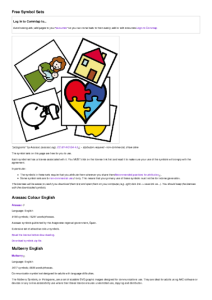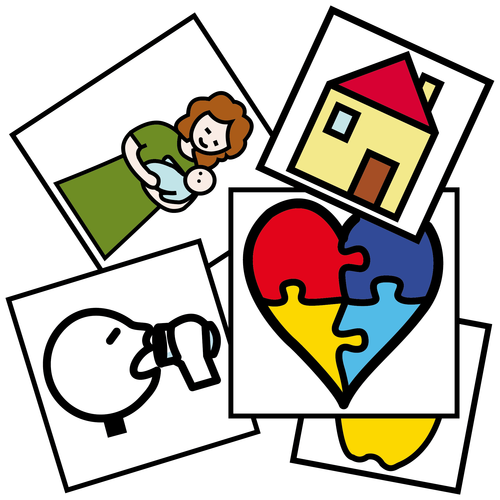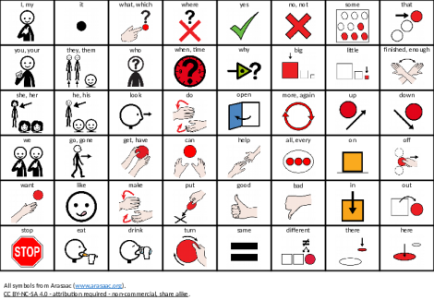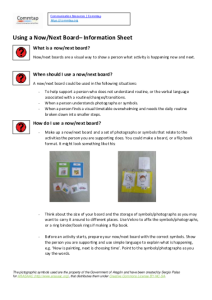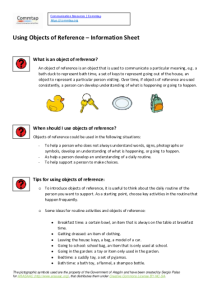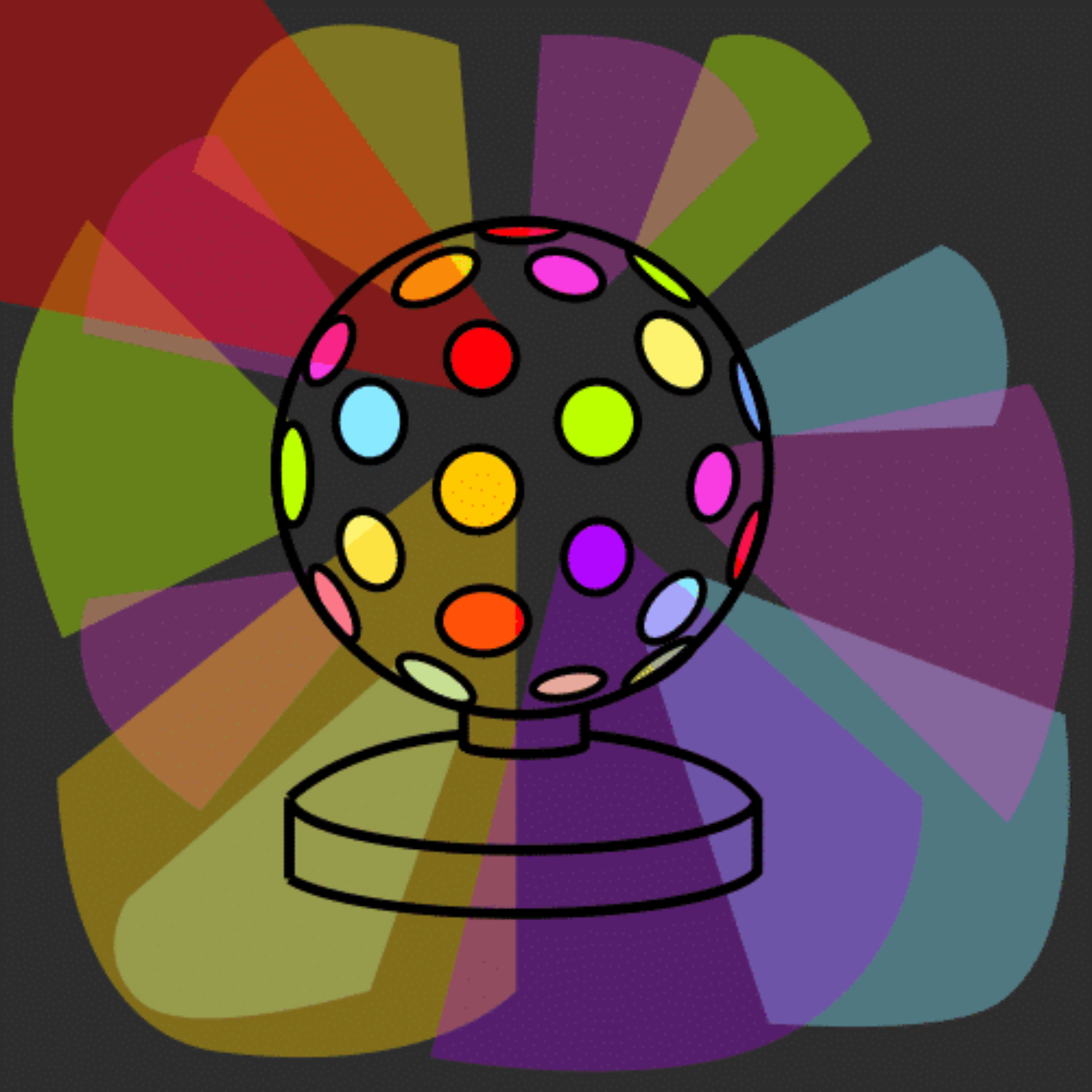Search
User login
Topic “Early communication”
Be familiar with written words
| Activity/strategy name and materials required | How to do the activity | Key principles for doing the activity and comments |
|---|---|---|
| Word labels in any lesson/situation
|
| The goal is simply for the child to become familiar with the written words and begin to link them to language. You are not expecting them to use the words in any way - though if they do point at word, confirm what they have pointed to - and respond appropriately. Refer to the written words naturally during talking. Make sure you refer to the written word often. Don't "test" the child - e.g. don't say "point to the word for this". You can facilitate errorless communication - for example "which one shall we put in next" - with a choice of words to choose from: then go with the child's response and include the word in your spoken response to them. |
Core communication board
Core communication board using ARASAAC symbols (https://arasaac.org). For use with everyday communication.
Note: if re-distributing with the ARASAAC symbols, this must be done non-commercially only.
You can make your own core communication board using different symbols with the Commtap Symboliser for PowerPoint.
Created 25 June 2022; updated 6 December 2024.
Activities to develop early choice making between two items
| Activity/strategy name and materials required | How to do the activity | Key principles for doing the activity and comments |
|---|---|---|
| Choosing Between Toys - Desired and undesired toys, other objects | To begin with hold out a liked toy and a neutral object like a piece of paper - encourage the child to reach for what they want. When they can do this consistently hold out two toys - encourage the child to reach to choose. | Vary which side you hold the toys out to ensure that the child doesn't always reach in one direction. Occasionally, when the child has been reaching for what they want swap the toys around and see whether they still reach for the same one. Always label what they choose for example "snake ... you want the snake...". |
| Choosing Between Food - Two types of food | As above Always label what the child chooses or reaches for. For example: 'Oh, rice, mmmm' Make appropriate sounds like 'mmmmmm', 'yum yum' etc. |
makes marks
| Activity/strategy name and materials required | How to do the activity | Key principles for doing the activity and comments |
|---|---|---|
| Imitates vertical strokes Writing tools and paper Washing up brush and bucket of water Sand tray Play dough | (1) Start by making big vertical strokes with a washing up brush and a pail of water outside on a fine day. Say "Down ... down" (2) Give the brush to the child (3) Reward any attempts to make a downward stroke for example with clapping, praise etc. (4) Follow this procedure in the sand or in a rolled out piece of play dough etc. (5) Use a chunky crayon (not too long) and a piece of paper. Say 'Down ......down.' (6) Give the crayon to the child (7) Reward success with praise or reward toys. (8) Use a ruler to make two vertical tramlines on the page and then help the child draw between the lines in a downward motion. (9) Draw two or three tramlines on a page well spaced - and see if the child can start at the top and draw down. (10) Draw big dots in a downward line and make the starting off dot big and red. Model for the child drawing a downward line roughly along this line of dots. You may need to start the child off and stop half way down the line for the child to complete. (11) Use different colours and writing tools to make the task more interesting. Reward attending to the task with social praise or a reward toy. |
Developing awareness that an object exists when out of sight
| Activity/strategy name and materials required | How to do the activity | Key principles for doing the activity and comments |
|---|---|---|
| Peek-a-boo - A toy that your child is motivated by. - A small blanket. |
| Only do this activity when the child is interested in the toy and is likely to want to continue to play with it Keep other distractions to a minimum - if there are other toys for them to play with they may not look for the hidden toy If the child is not aware that the toy still exists, gain their attention and lift up the cloth. 'Here it is!' Let the child play with the toy again |
Developing turn taking using sensory toys
| Activity/strategy name and materials required | How to do the activity | Key principles for doing the activity and comments |
|---|---|---|
| Sensory Suitcase Use a small box or bag to collect toys which target different sensory areas e.g. Auditory (noisy toys) toys (rattles, squeakers, shakers, musical items, drums etc.) Visual toys (flags, streamers, Slinkies, spinners, bubbles, flashing items, torches, pop-up toys, windmills etc.) Tactile toys (toys that feel different) (balls of different textures to squeeze, brushes of different textures to be tickled with, materials e.g. velvet, sandpaper, feathers, pots of rice/macaroni to feel, Play dough to squeeze/cut ) Scented toys (play dough, Plasticine, some rubber toys) | 1. Collect some toys from each of the sensory categories described. 2. Store the toys in a container which you use only for this specific activity and is otherwise stored away from children. 3. Find a quiet comfortable place to work either at a table or on the floor. Try to make sure the child cannot easily run off or get distracted. 4. Make a show of shaking the suitcase and seeming happy about the approaching activity. 5. Take out two toys from different sensory categories and place them in front of the child - note which category of item the child chooses/reaches for and put the other item back in the suitcase. 6. Allow the child a short time to enjoy the item chosen then say 'Your name's turn' (e.g. "Mary's turn") and gently but firmly take the item for your turn. 7. Use the toy for a short time then offer it the child again. Say 'Child's name's turn'. 8. Repeat a few times but stop before the child gets bored. 9. Start the process again by offering the child a choice of toys from two different sensory categories and then follow the turn taking routine. 10. Continue with the activity for approximately 10 minutes - stop before the child gets bored. 11. Store the sensory suitcase in a secure place until the next session.
| These activities are based on a child's sensory preferences. Some children love visual toys but are frightened of noisy (auditory) toys. Accept these preferences and work with the sensory areas the child is comfortable with. Some children will choose some kinds of noisy toys and reject others or show fear when presented with others. Some children are frightened of feathers but love being tickled with a shaving brush. Experiment and observe! Sensory preferences can change over time as well! Keep the activity fun and show that you are enjoying it too! Make the activity time limited so that it stays special. Do the activity regularly and change the items used from time to time. |
| Create Colourful Patterns Use a selection of the following: Paint pots and brushes, felt tips, computer painting programme, pots with different coloured bits of paper to stick and a sheet of paper. | ||
| Messy Play Use, for example, one of the following sets of items: Sand tray with spades, pots etc. Water tray with pots, sieves, pourers etc Rice tray with pots and pourers etc |
Developing attention and listening skills through motivating activities
| Activity/strategy name and materials required | How to do the activity | Key principles for doing the activity and comments |
|---|---|---|
| Sensory Play - Sensory toys and materials for messy play (e.g. trays with sand/ cornflour and water/jelly). - The best toys are those that the child can manipulate easily to produce a result. | 1. Guide your child's hands and visual attention to toys/trays of material(s) that they can touch and look at. 2. Let your child explore the toys/materials in the tray and encourage them to investigate all their properties, stimulating all of the child's senses as far as possible (colour, smell, texture). 3. You may need to draw the child's attention back to the activity if the child becomes distracted. Use your voice to regain their attention (e.g. a drawn out "ohhhh!", or an intake of breath). | Do not continue with something the child has lost interest in, but wait a while before introducing another object. |
| Turn taking games - Ball / dark cloth - Your voice - to sing simple nursery rhymes that have an element of anticipation built in such as "Round and round the haystack, like a little mouse, one step, two step and into his little house". | This is a fun activity for you and the child to enjoy together. Use plenty of facial expression and your voice to gain and keep the child's attention. |
consistently acts on objects
| Activity/strategy name and materials required | How to do the activity | Key principles for doing the activity and comments |
|---|---|---|
| Playing with action toys Drum Jack in a box Pop-up toys Toys which need to be squeezed or a button pushed to produce an effect | Sit in the child's sight line in a quiet room and choose an action type toy to have on your lap. Gain the child's attention by stroking their face/clapping your hands or calling their name. Use the toy. Show happiness and/or surprise as you do so. Wait to see if the child makes a move to request a repeat. Repeat the action if the child requests. If the child does not request a repeat do the action again as above. After a few repeats take the child's hand and help the child activate the toy. Gradually reduce the amount of help you give the child to activate the toy. Can the child activate the toy independently if you show the child the toy? Move on to a different toy and follow the procedure above. | Work in short bursts. Keep the experience fun and light hearted. Give the child enough time to explore the toys and enough time to try to use the toy themselves. Give lots of praise for any success. |
| Snack time Small edible treats (biscuits/fruit/crisps) Transparent container with a lid. | You want the child to be able to open the container independently and help themselves. Give lots of time to explore the objects and praise for any success. Give lots of opportunities to learn by repeating the activity. | |
| Favourite toy Small toys e.g. car/squashy ball |
matches related everyday objects
| Activity/strategy name and materials required | How to do the activity | Key principles for doing the activity and comments |
|---|---|---|
| Find and match Pairs of related objects, for example: pencil and paper sock and a shoe bar of soap and a flannel, toothbrush and a tube of toothpaste hammer and nail knife and fork box | 1. Select pairs of related objects; 2. Place one member of each of the object pairs in front of the child (e.g. pencil, sock, soap, toothbrush); 3. Place the remaining objects (e.g. paper, shoe, flannel, toothpaste) in a box; 4. Have the child pick an object from the box and ask them to "Find the one we use with this"; 5. Repeat with the rest of the objects in the box. | If necessary, demonstrate how the objects go together, or get the child to show you. If the child chooses the wrong item, you can look puzzled and try and use those items together. For example try and write on the paper with a toothbrush. Then you can try and find the right item, and look pleased with yourself/ express happiness when you find you can make marks on the paper. |
removes object from face that obscures vision
| Activity/strategy name and materials required | How to do the activity | Key principles for doing the activity and comments |
|---|---|---|
| Cloth and Peek-a-boo Place cloth over Child's face | Place cloth on Child's face, wait and see if he makes any reaction, then pull it off saying 'peek-a-boo' | Child will need time to become familiar with the routine of the activity Use simple words like 'gone' and 'hello' |
| Cloth and Song 'Where is Child? Where is Child? Here he is! Here he is!' To the tune of 'Frere Jaques' | Child will need time to become familiar with the routine of the activity |
puts and takes objects into and out of container
| Activity/strategy name and materials required | How to do the activity | Key principles for doing the activity and comments |
|---|---|---|
| Box and Bricks Box Bricks | Empty the bricks on the floor or table Help child pick up a brick and place it in the box... Remember to use simple words like 'in', 'more'... When all the bricks are in the box say 'all in, no more!' (or something similar!) Then help child take them out again - say 'out', 'more' etc | Initially he might need to be helped (hand-over-hand) to pick up brick, place hand in/near box and prompted to drop it The aim to develop child's ability to do this more and more independently... |
| Post Box Commercial or home made post box, pictures or objects to post | Remember to use simple words and comment on what is happening... | |
| Monkey Eating Monkey box and plastic food | Remember to use simple names ( 'apple') and 'in' and noises like 'mmm', 'yum yum' etc |
Support Commtap to keep it online
Thank you for visiting Commtap.
Please read this message as it is extremely important.
- Visitor donations mean we can continue to host over 1,000 free activities to support speech, language, and communication development.
- Visitor donations mean we can continue to provide free resources to address a wide range of communication needs, including limited speech or language, interaction challenges, and needs associated with conditions such as developmental language disorder, autism, and cerebral palsy.
- Visitor donations mean we can continue to provide resources to support the work of speech and language therapists, teachers, teaching assistants, parents, and carers.
- Visitor donations mean we can continue to provide the free key word sign dictionary (bks.org.uk) which has over 2,000 Makaton and Signalong signs.
We know that not everyone is able to afford to pay to access these resources, however, if you can, please make a donation to keep the site going.
Thank you
Google ads on this page are provided by Google Adsense - and their presence does not imply any endorsement by Commtap. Report a problem with an ad on this page. Log in (for free) to avoid seeing Google ads.
